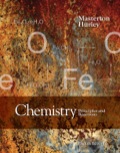
Interpretation:
From the given table, the polymer with the largest molar mass needs to be determined. Assuming the number of monomer units are same in all the
Concept introduction:
A polymer is a long chain consists of large number of monomer units. In a polymer, the monomers are linked to each other in a continuous or repetitive manner. These monomer units are linked to each other either through the formation of peptide linkage, glycosidic linkage or by removal of any moiety such as a water molecule. Polyvinyl chloride, Bakelite and polystyrene are some of the examples of polymers.
Answer to Problem 7QAP
The molar mass of styrene is largest of all and thus polystyrene has the largest molar mass.
Explanation of Solution
If all the polymers contain the same number of monomer units, the molar mass of polymers can be compared by comparing the molar mass of monomers in it.
(1)
In the table mentioned in the problem, the 1st polymer contains ethylene as a monomer unit. Ethylene consists of 2 carbon and 4 hydrogen atoms. The molar mass can be calculated as follows:
Putting the values,
(2)
The 2nd polymer shown in table consists of propylene as a monomer unit. Propylene consists of 3 carbon and 6 hydrogen atoms.
The molar mass can be calculated as follows:
Putting the values,
(3)
The 3rd polymer shown in table consists of vinyl chloride as monomer unit. Vinyl chloride consists of 2 carbon and 3 hydrogen and 1 chlorine atom.
Putting the values,
(4)
The 4th polymer shown in table consists of acrylonitrile as monomer unit. Acrylonitrile consists of 3 carbon, 3 hydrogen and 1 nitrogen atoms. The molar mass can be calculated as follows:
Putting the values,
(5)
The 5th polymer shown in table consists of styrene as monomer unit. Styrene consists of 8 carbon and 8 hydrogen atoms. The molar mass can be calculated as follows:
(6)
The 6th polymer shown in table consists of methyl methacrylate as monomer unit. Methacrylate consists of 2 carbon and 2 oxygen atoms. The molar mass can be calculated as follow:
Putting the values,
(7)
The 7th polymer shown in table consists of tetrafluoroethylene as monomer unit. Tetrafluoroethylene consists of 2 carbon and 4 fluorine atoms. The molar mass can be calculated as follows:
Putting the values,
The molar mass of styrene (5) is largest of all and thus polystyrene have the largest molar mass.
Thus, the molar mass of polystyrene is maximum.
Want to see more full solutions like this?
Chapter 23 Solutions
EBK CHEMISTRY: PRINCIPLES AND REACTIONS
- 8:17 PM Sun Mar 30 Draw the major product of this reaction. Ignore inorganic byproducts. HSCH2CH2CH2SH, BF3 Probler Drawing Ato Bonds Clarrow_forwardpresented by Mr L How the coprion. (Il Done in no wraction, dew the starting redential) доarrow_forward8:16 PM Sun Mar 30 K Draw the major product of this reaction. Ignore inorganic byproducts. Proble 1. CH3MgBr 2. H3O+ F Drawingarrow_forward
- о но оarrow_forwardName the major organic product of the following action of 4-chloro-4-methyl-1-pentanol in neutral pollution 10+ Now the product. The product has a molecular formula f b. In a singly hain, the starting, material again converts into a secule with the molecular kormula CIO. but with comply Draw the major organic structure inhalationarrow_forwardMacmillan Learning Alcohols can be oxidized by chromic acid derivatives. One such reagent is pyridinium chlorochromate, (C,H,NH*)(CICTO3), commonly known as PCC. Draw the proposed (neutral) intermediate and the organic product in the oxidation of 1-butanol by PCC when carried out in an anhydrous solvent such as CH₂C₁₂. PCC Intermediate OH CH2Cl2 Draw the intermediate. Select Draw Templates More с H Cr о Product Draw the product. Erase Select Draw Templates More H о Erasearrow_forward
- If I have 1-bromopropene, to obtain compound A, I have to add NaOH and another compound. Indicate which compound that would be. A C6H5 CH3arrow_forwardProvide the reagents for the following reactions.arrow_forwardIf I have 1-bromopropene, to obtain compound Z, I have to add two compounds A1 and A2. Indicate which compounds are needed. P(C6H5)3arrow_forward
- Draw the major product of this reaction. Ignore inorganic byproducts. Assume that the water side product is continuously removed to drive the reaction toward products. O CH3CH2NH2, TSOH Select to Draw >arrow_forwardPredict the major organic product(s) for the following reaction.arrow_forwardPredict the major organic product(s) for the following reactions.arrow_forward
 Chemistry: Principles and ReactionsChemistryISBN:9781305079373Author:William L. Masterton, Cecile N. HurleyPublisher:Cengage Learning
Chemistry: Principles and ReactionsChemistryISBN:9781305079373Author:William L. Masterton, Cecile N. HurleyPublisher:Cengage Learning Introductory Chemistry: An Active Learning Approa...ChemistryISBN:9781305079250Author:Mark S. Cracolice, Ed PetersPublisher:Cengage Learning
Introductory Chemistry: An Active Learning Approa...ChemistryISBN:9781305079250Author:Mark S. Cracolice, Ed PetersPublisher:Cengage Learning Chemistry: The Molecular ScienceChemistryISBN:9781285199047Author:John W. Moore, Conrad L. StanitskiPublisher:Cengage Learning
Chemistry: The Molecular ScienceChemistryISBN:9781285199047Author:John W. Moore, Conrad L. StanitskiPublisher:Cengage Learning World of Chemistry, 3rd editionChemistryISBN:9781133109655Author:Steven S. Zumdahl, Susan L. Zumdahl, Donald J. DeCostePublisher:Brooks / Cole / Cengage Learning
World of Chemistry, 3rd editionChemistryISBN:9781133109655Author:Steven S. Zumdahl, Susan L. Zumdahl, Donald J. DeCostePublisher:Brooks / Cole / Cengage Learning Principles of Modern ChemistryChemistryISBN:9781305079113Author:David W. Oxtoby, H. Pat Gillis, Laurie J. ButlerPublisher:Cengage Learning
Principles of Modern ChemistryChemistryISBN:9781305079113Author:David W. Oxtoby, H. Pat Gillis, Laurie J. ButlerPublisher:Cengage Learning Chemistry: An Atoms First ApproachChemistryISBN:9781305079243Author:Steven S. Zumdahl, Susan A. ZumdahlPublisher:Cengage Learning
Chemistry: An Atoms First ApproachChemistryISBN:9781305079243Author:Steven S. Zumdahl, Susan A. ZumdahlPublisher:Cengage Learning





